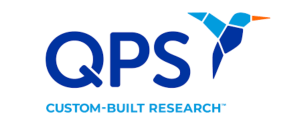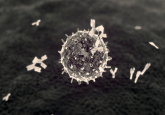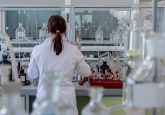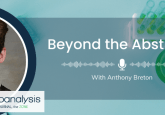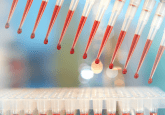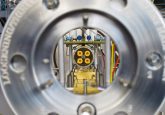The new frontier: immunogenicity testing for cell and gene therapies
In the second episode of ‘The new frontier’, we spoke to Senior Director Johanna Mora about her experience with immunogenicity testing for cell and gene therapies (CGTs) and how she prepared for the expansion of BMS’s portfolio to include CGTs. We discuss the importance of having diverse teams with a broad range of experiences to solve complex problems, as well as the role of artificial intelligence in improving our efficiency and spotting patterns in the data.
Podcast transcript
[00:07] Ellen Williams: Hello and welcome to the first episode of the Bioanalysis Zone podcast on Cell and Gene Therapies, sponsored by QPS Holdings. I am your host, Ellen Williams, and today I am joined by Johanna Mora, who is the Senior Director in Clinical Pharmacology, Pharmacometrics, Disposition and Bioanalysis at Bristol Myers Squibb. Thank you very much for being here, Joanna. So, could you start by telling us a little bit more about how you got into cell and gene therapy research and how your current role relates to the field?
[00:35] Johanna Mora: Hi Ellen, thank you for having me. Regarding my role, I lead a group of eight bioanalytical leads that span PK immunogenicity strategy for programs in our portfolio across all modalities. So, when the BMS portfolio grew to include cell and gene therapy we had to come up to speed and I had to learn a lot more about immunology so that our strategies would be solid, especially on the immunogenicity side. About a year ago, one of my mentors gifted the book called ‘The Song of the Cell’ by Siddhartha Mukherjee and if you are in a similar situation as I was, I highly recommend you picking up the book. He does a great job of giving you all the historical information, molecular biology, immunology, all the background you need to understand where we started and how … we are where we are today in terms of cell therapy and how beneficial it’s been to patients like Emily Whitehead as she was cured from cancer.
[01:36] Johanna Mora: Regarding gene therapy, we are talking about introducing a gene in the patient perhaps as a defective expression of a protein or completely absent that’s causing a disease. And on the cell therapy side, those modifications that are done in vivo in the gene therapy space are done extracellularly and as the cells are removed from the patient, then we’re introducing those back so a lot for us to consider in terms of what the immunogenicity risk for these modalities could be.
[02:11] Ellen Williams: The absolute breadth of cell and gene therapies already and their different mechanisms and what we are now able to start treating is really extraordinary and it is a very exciting field to be in, I imagine.
[02:27] Johanna Mora: We are definitely very privileged to be part of drug development processes for these new modalities and very lucky that our company has such a wide portfolio. It makes it exciting to come to work.
[02:39] Ellen Williams: I’m sure. Could you maybe explain in a little bit more detail why cell and gene therapies in particular require those additional bioanalytical considerations above the safety aspect?
[03:01] Johanna Mora: So I joined BMS back in 2007. At that time, there were a couple of ways we were doing PK assessments, it was either by LC-MS or ligand binding assays for immunogenicity. As our portfolio expanded, then we also started exploring methodologies such as affinity capture LC-MS, kind of like the child between the other two platforms, and then again as we got into other modalities then hybridization ELISAs came into play. Now with cell and gene therapy, we’re bringing in PCR to support PK assessments and the way that I look at this is you’re just looking in your toolbox to figure out what’s best to answer the question at hand.
[05:39] Ellen Williams: So much of your work focuses on immunogenicity assessments for cell and gene therapies. Could you maybe explain more about how CGTs are currently being monitored for immune response?
[05:54] Johanna Mora: You can think about it like the bread and butter, which we do for all biotherapeutics, is to look at the humoral adaptive immune response. That’s like anti-drug antibodies that were generated right, and we use ligand binding assays for that. There’s also a cellular immunogenicity component that we have to consider and, in some cases, the immunogenicity risk assessment may justify that we collect the samples and only analyze if there is a safety or PK change that cannot be explained by looking at the humoral response. That’s mostly the strategy that we implement for cell therapy.
[06:32] Johanna Mora: Gene therapy has additional considerations and there’s an IQ consortium that put together a manuscript that came out in 2007* [1]. They do a great job in explaining the immunogenicity risks for gene therapy. So, I just want to direct your audience to go back and look at that manuscript. If you think about AAV responses, those are extremely important to monitor, both the humoral and the cellular responses. But then when you get into thinking about responses to the transgene protein then we have to go back and think about the risk assessment. Where are we dosing? Is the dosing frequent or is it a single dose? Is the transgene protein being expressed intracellularly or extracellularly? Because all that would affect the immunogenicity risk and the strategy that gets put behind it. So, it’s very important for us to look back at White Papers that were from discussions that perhaps we had at WRIB or other conferences and make sure that we are aligned on what the immunogenicity risk is and the strategy behind it.
[07:42] Ellen Williams: There seems to be some very key documents and key meetups over the year that brings together the scientists from within the field and actually this is where a lot of the key discussions happen. They seem to have been pretty instrumental in guiding best practices, sharing information between research groups.
[08:36] Johanna Mora: Discussions that we have across the industry are critical. I meet with the bioanalytical leads in my team. We go back to those White Papers over and over or to know it’s from different conferences, as we’re coming up with a strategy that we’re going to implement for our specific program. And in some cases, they’re important not just for ourselves, but when we go back to our drug development teams to justify the strategy that we put together, people come from different backgrounds and experiences, and this is good to have such manuscripts to enrich those discussions that we have within our company.
[09:18] Ellen Williams: Yeah definitely. Just being able to get all of those different perspectives and like you said bringing them back to your team and sharing them and passing on the message, it is just such an important process and I think the field feels as though it is really benefited from those conversations.
[09:36] Johanna Mora: We absolutely benefit from those discussions, getting different perspectives. If you think about it, I may have experience with a gene therapy program but maybe it was dosed in a different space than a program that my friend at company X, Y or Z had. [In a] cell therapy program that I supported, there was very high immunogenicity incidents compared to another one, so it’s good to sit down and learn from each other and put together recommendations for the rest of the industry.
* This manuscript was published in 2022 and can be found here.
[10:07] Ellen Williams: Something that I wanted to quickly ask you what do you think of as being some of the most impactful work currently in the field? Is there a particular cell and gene therapy, or maybe technique that you think is particularly exciting at the moment?
[10:28] Johanna Mora: That’s a good question. I don’t know that I have a single example to pick. When I look at the history and how far scientists have advanced in this area [and] the safety challenges that were faced, particularly for gene therapy, that were overcome, I’m in awe of how people have really persevered in this space. Yes, it’s not just a single one but the collective effort, that’s what I’m most excited about.
[11:00] Ellen Williams: That is so nice to hear that actually it is not necessarily a technique or a therapeutic that is the most exciting is the perseverance and the work that the community is put in.
[11:14] Johanna Mora: When you think about this, again let’s emphasize the diversity, the collective effort, people from different backgrounds coming together to solve issues. If you want to support something well you have to understand it, so if this area is new for you, again, talk about ‘The Song of the Cell’, send people to go and get the book and learn about this space. I mean these [are] really exciting times. Now we can think about artificial intelligence and how it’s going to perhaps help us advance in other areas. I’m exciting to see what that’s going to bring.
[11:49] Ellen Williams: Yeah, definitely. Do you think that artificial intelligence is going to maybe be that slingshot that accelerates some of the cell and gene therapy work?
[11:58] Johanna Mora: I do think that artificial intelligence is going to help us. There are some interesting discussions that people are having, maybe looking at collective data that has been generated across the years, can we use that to justify strategies. As the collective data grows, are there patterns that artificial intelligence is going to help us see or are there areas in perhaps the challenges we have right now in the manufacturing process that could be overcome with artificial intelligence? I don’t know, I guess I lack the particular vision of where it’s going to really help us sweep through, but what I do know is that it will help us become more efficient and I’m excited for that.
[12:40] Ellen Williams: I think it is so difficult to be able to predict how it is going to impact every single therapeutic, technique, but I think you’re right. I think it is going to give people that efficiency and hopefully fast-track some of the work that we are doing now and hopefully we’ll get some very exciting therapeutics out to the patients that need them. So, it is been an absolute pleasure to speak to you, Johanna. Do you have any kind of last things to mention before we finish up?
[13:08] Johanna Mora: Yeah before we finish, I want to remind everyone about the importance of diversity within your teams, bringing in people from different perspectives, different backgrounds. Don’t hire the same kind of people all the time. We can all learn from each other and help programs progress faster when we really open our minds to that.
[13:27] Ellen Williams: That sounds like very solid advice. I am a firm believer , that the best teams and the most effective teams are diverse teams. Whether that be field, whether that be past experience, it is so important to get the different perspectives and have somebody see the problem in a different way than you do is actually really important.
[13:53] Johanna Mora: It is been a pleasure to spend time with you today. Thank you so much for the invitation.
[13:57] Ellen Williams: It is been amazing to have you on. Before we drop off, you have done some work with Bioanalysis Zone in the past and we’ve have published an interview with you within the last 12 months, so if people are wanting to read a little bit more about the work that you do, they will be able to go and read that article. I know you have pointed them to your favorite book as well, so they have got lots of extra reading to do after this episode I think. Thank you so much, Johanna.
[14:25] Johanna Mora: Thank you.
About the speaker:
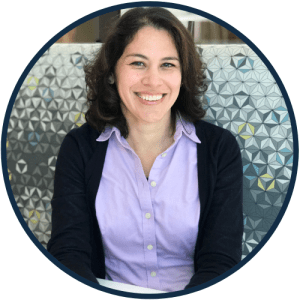 Johanna R. Mora, PhD
Johanna R. Mora, PhD
Senior Director
Bristol-Myers Squibb (NJ, USA)
Dr Mora is currently a Senior Director in Clinical Pharmacology, Pharmacometrics, Disposition and Bioanalysis at Bristol-Myers Squibb (BMS). She received a Bachelor of Science degree in Chemistry from the University of Costa Rica (San Pedro, Costa Rica) in 1999 and a PhD in Analytical Chemistry from the University of Kansas (KS, USA) in 2004. At BMS she has oversight of the PK and immunogenicity strategy for programs across all therapeutic areas. Johanna is a mentor to her team, an author of over 20 scientific publications and has served in several cross-functional teams within BMS. She is an active member of the American Association of Pharmaceutical Scientists and has served in the Emerging Technology Focus group and the Therapeutic Product Immunogenicity Community. Johanna has also held active roles within the Applied Pharmaceutical Analysis Regulated Bioanalysis Committee.
If you enjoyed Johanna’s episode, you can read more about her work here.
![]() Listen to other episodes in this series here.
Listen to other episodes in this series here.
![]() Be the first to hear about the next episode by signing up for email notifications!
Be the first to hear about the next episode by signing up for email notifications!
Source:
[1] Yang T-Y, Braun M, Lembke W et al. Immunogenicity assessment of AAV-based gene therapies: An IQ consortium industry white paper. Mol. Ther. Methods. Clin. Dev. 2(26), 471-494 (2022).


